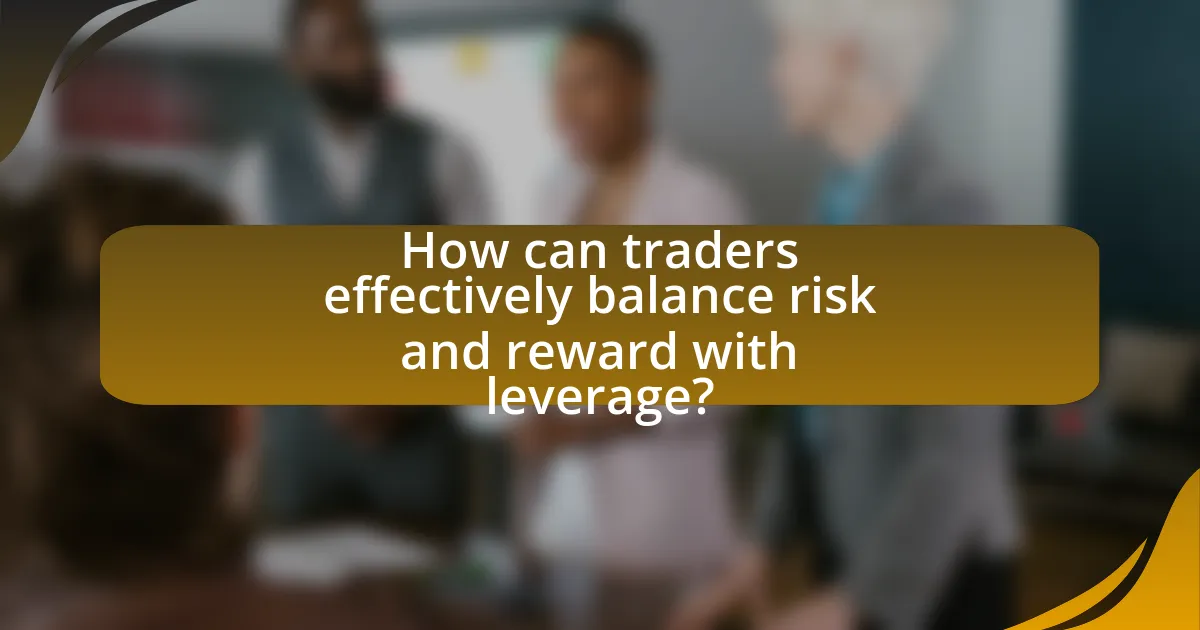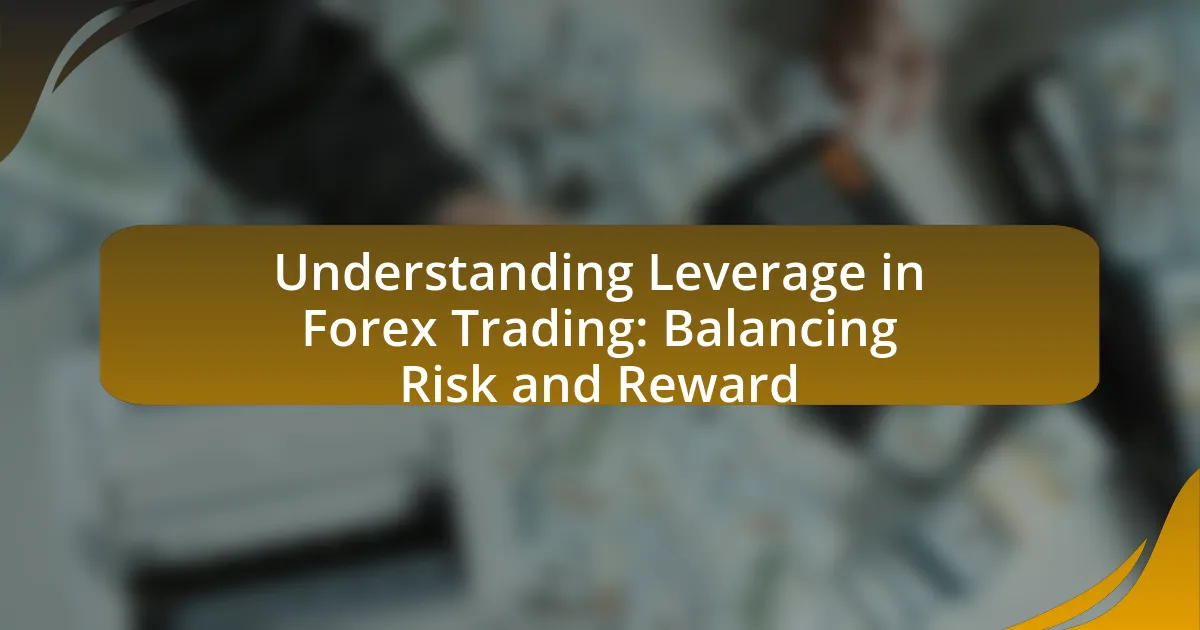Leverage in Forex trading is the practice of controlling larger market positions with a smaller amount of capital, allowing traders to amplify potential profits and losses. This article explores the mechanics of leverage, including its key components such as margin, position size, and leverage ratios, while emphasizing the importance of risk management strategies to mitigate associated risks. It also discusses the impact of leverage on trading positions, the advantages it offers, and the potential for significant financial losses if not managed properly. Additionally, practical tips for effective leverage usage and common mistakes to avoid are highlighted, providing a comprehensive understanding of how to balance risk and reward in Forex trading.

What is Leverage in Forex Trading?
Leverage in Forex trading refers to the ability to control a larger position in the market with a smaller amount of capital. Specifically, it allows traders to borrow funds to increase their trading exposure, which can amplify both potential profits and potential losses. For example, a leverage ratio of 100:1 means that for every $1 of the trader’s own capital, they can control $100 in the market. This mechanism is widely used in Forex markets, where traders often utilize high leverage to maximize their returns on investment, but it also increases the risk of significant losses.
How does leverage function in the context of Forex trading?
Leverage in Forex trading allows traders to control a larger position size with a smaller amount of capital. Specifically, it enables traders to borrow funds from their broker to increase their potential returns on investment. For example, a leverage ratio of 100:1 means that for every $1 of the trader’s own capital, they can control $100 in the market. This magnifies both potential profits and potential losses, making it a double-edged sword. According to the Commodity Futures Trading Commission, while leverage can enhance returns, it also increases the risk of significant losses, emphasizing the importance of risk management strategies in leveraged trading.
What are the key components of leverage in Forex?
The key components of leverage in Forex are margin, position size, and the leverage ratio itself. Margin refers to the amount of capital required to open and maintain a leveraged position, which is typically expressed as a percentage of the total trade size. Position size indicates the volume of currency being traded, directly affecting potential gains or losses. The leverage ratio, often expressed as a fraction (e.g., 100:1), determines how much larger a trader’s position can be compared to their margin, allowing for amplified exposure to market movements. For instance, with a leverage ratio of 100:1, a trader can control $100,000 in currency with just $1,000 in margin, illustrating the significant impact leverage has on both potential profits and risks in Forex trading.
How does leverage impact trading positions?
Leverage significantly amplifies both potential gains and losses in trading positions. When traders use leverage, they can control a larger position size with a smaller amount of capital, which increases the risk of substantial losses if the market moves against them. For example, with a leverage ratio of 100:1, a trader can control $100,000 in currency with just $1,000 of their own capital. This means that even a small price movement can lead to large percentage changes in the trader’s equity, highlighting the importance of risk management strategies.
Why is leverage important for Forex traders?
Leverage is important for Forex traders because it allows them to control larger positions with a smaller amount of capital, thereby amplifying potential returns. For instance, with a leverage ratio of 100:1, a trader can control $100,000 in currency with just $1,000 of their own funds. This capability enables traders to maximize their profit potential on small price movements in the Forex market, which is characterized by high liquidity and volatility. However, while leverage increases potential gains, it also significantly raises the risk of losses, making risk management crucial for successful trading.
What advantages does leverage provide in Forex trading?
Leverage in Forex trading allows traders to control larger positions with a smaller amount of capital, significantly amplifying potential profits. For instance, with a leverage ratio of 100:1, a trader can control $100,000 in currency with just $1,000 of their own funds. This capability enables traders to maximize their returns on investment, as even small market movements can lead to substantial gains. Additionally, leverage can enhance trading flexibility, allowing for more diverse trading strategies and opportunities in the Forex market.
How can leverage enhance potential profits?
Leverage enhances potential profits by allowing traders to control larger positions with a smaller amount of capital. For instance, in Forex trading, a leverage ratio of 100:1 means that for every $1 of capital, a trader can control $100 in the market. This amplification of investment can lead to significantly higher returns on the initial capital if the trade is successful. According to a report by the Bank for International Settlements, the Forex market’s daily trading volume exceeds $6 trillion, illustrating the scale at which leverage can be applied to maximize profit potential.

What are the risks associated with leverage in Forex Trading?
The risks associated with leverage in Forex trading include the potential for significant financial loss, as leverage amplifies both gains and losses. When traders use leverage, they can control larger positions with a smaller amount of capital, which increases the risk of losing more than their initial investment. For instance, a leverage ratio of 100:1 means that a 1% adverse movement in the market can result in a 100% loss of the trader’s capital. Additionally, high leverage can lead to margin calls, where traders are required to deposit more funds to maintain their positions, potentially forcing them to liquidate assets at unfavorable prices. According to a report by the European Securities and Markets Authority (ESMA), retail Forex traders often face a high risk of losing money due to the use of leverage, with approximately 74-89% of retail investor accounts losing money when trading CFDs.
How can leverage lead to significant losses?
Leverage can lead to significant losses by amplifying both gains and losses in trading. In Forex trading, for instance, a trader using high leverage can control a large position with a relatively small amount of capital. If the market moves against the trader’s position, the losses can exceed the initial investment, resulting in a margin call or account liquidation. Historical data shows that traders using leverage of 100:1 can lose their entire investment in a matter of minutes if the market moves just 1% against them. This illustrates how leverage, while offering the potential for higher returns, also increases the risk of substantial financial loss.
What is the relationship between leverage and margin calls?
Leverage and margin calls are directly related in trading, particularly in forex. Leverage allows traders to control larger positions with a smaller amount of capital, increasing both potential profits and risks. When the market moves against a trader’s position, the equity in their account may fall below the required margin level, triggering a margin call. This call demands that the trader deposit additional funds to maintain their position or risk having it liquidated. For instance, with a leverage ratio of 100:1, a small price movement can significantly impact the account balance, leading to a higher likelihood of margin calls if the market is volatile.
How does high leverage increase volatility in trading?
High leverage increases volatility in trading by amplifying the effects of price movements on a trader’s capital. When traders use high leverage, they control larger positions with a smaller amount of their own capital, which means that even minor fluctuations in the market can lead to significant gains or losses. For instance, with 100:1 leverage, a 1% change in the asset price results in a 100% change in the trader’s equity. This heightened sensitivity to price changes inherently increases the volatility of the trading outcome, as the potential for both profit and loss is magnified.
What strategies can mitigate risks when using leverage?
To mitigate risks when using leverage, traders can implement strategies such as setting stop-loss orders, diversifying their portfolio, and using lower leverage ratios. Stop-loss orders automatically close positions at predetermined price levels, limiting potential losses. Diversification across different currency pairs reduces exposure to any single asset’s volatility, thereby spreading risk. Additionally, using lower leverage ratios decreases the potential for significant losses, as it requires less capital to control a position, which can lead to more sustainable trading practices. These strategies are supported by the fact that many successful traders emphasize risk management as a key component of their trading approach, highlighting that effective risk mitigation can lead to more consistent profitability in leveraged trading environments.
How can traders effectively manage their leverage levels?
Traders can effectively manage their leverage levels by using a conservative approach to leverage ratios, typically not exceeding 2:1 for most trades. This conservative strategy minimizes the risk of significant losses, as higher leverage amplifies both potential gains and losses. According to a study by the Financial Conduct Authority, traders using lower leverage are less likely to experience margin calls and account wipeouts, highlighting the importance of risk management in trading practices. Additionally, traders should regularly assess their risk tolerance and adjust their leverage accordingly, ensuring that their trading strategy aligns with their financial goals and market conditions.
What role does risk management play in leveraging?
Risk management plays a critical role in leveraging by mitigating potential losses associated with high-risk investments. In forex trading, leveraging allows traders to control larger positions with a smaller amount of capital, which amplifies both potential gains and losses. Effective risk management strategies, such as setting stop-loss orders and position sizing, help traders limit their exposure and protect their capital, thereby ensuring that they can sustain their trading activities over the long term. According to a study by the Bank for International Settlements, proper risk management practices can significantly reduce the likelihood of catastrophic losses in leveraged trading environments.

How can traders effectively balance risk and reward with leverage?
Traders can effectively balance risk and reward with leverage by implementing strict risk management strategies, such as setting stop-loss orders and limiting the amount of capital allocated to leveraged positions. By using stop-loss orders, traders can automatically exit a trade at a predetermined loss level, thereby protecting their capital from significant downturns. Additionally, limiting leverage to a manageable ratio, such as 2:1 or 3:1, helps mitigate potential losses while still allowing for substantial gains. Research indicates that traders who utilize risk management techniques are more likely to achieve long-term profitability, as evidenced by a study from the Journal of Financial Markets, which found that disciplined risk management can improve trading outcomes significantly.
What are the best practices for using leverage in Forex trading?
The best practices for using leverage in Forex trading include understanding the risks involved, using lower leverage ratios, and implementing strict risk management strategies. Traders should be aware that high leverage can amplify both gains and losses, making it crucial to choose a leverage level that aligns with their risk tolerance and trading strategy. For instance, using a leverage ratio of 1:10 or lower is often recommended for beginners to mitigate potential losses. Additionally, employing stop-loss orders can help protect capital by automatically closing positions at predetermined loss levels. According to a study by the Financial Conduct Authority, traders who utilize risk management techniques, including appropriate leverage, are more likely to achieve long-term success in Forex trading.
How can traders set appropriate leverage ratios?
Traders can set appropriate leverage ratios by assessing their risk tolerance, trading strategy, and market conditions. Risk tolerance determines how much capital a trader is willing to risk on a single trade; for instance, a conservative trader may opt for a lower leverage ratio, such as 1:10, to minimize potential losses. The trading strategy also influences leverage; scalpers may use higher leverage ratios, like 1:100, to capitalize on small price movements, while long-term investors typically prefer lower leverage. Additionally, market conditions, including volatility and liquidity, should be considered; during high volatility, lower leverage is advisable to protect against rapid price swings. According to the Financial Conduct Authority, excessive leverage can lead to significant losses, emphasizing the importance of setting ratios that align with individual risk profiles and market dynamics.
What tools can assist in managing leverage effectively?
Risk management tools such as stop-loss orders, margin calculators, and trading platforms with leverage management features assist in managing leverage effectively. Stop-loss orders automatically close a position at a predetermined price, limiting potential losses. Margin calculators help traders understand the required margin for their positions, ensuring they do not over-leverage. Trading platforms like MetaTrader and cTrader offer built-in tools for monitoring and adjusting leverage levels, allowing traders to maintain control over their risk exposure. These tools collectively enhance a trader’s ability to balance risk and reward in Forex trading.
What common mistakes should traders avoid when using leverage?
Traders should avoid over-leveraging, which occurs when they use excessive borrowed funds relative to their capital. Over-leveraging can lead to significant losses, as even small market fluctuations can result in margin calls or account liquidation. According to a study by the Financial Conduct Authority, 82% of retail traders lose money when trading with high leverage, highlighting the risks associated with this practice. Additionally, traders should refrain from neglecting risk management strategies, such as setting stop-loss orders, which can help mitigate potential losses. Lastly, emotional trading, driven by fear or greed, often leads to poor decision-making and should be avoided to maintain a disciplined trading approach.
How can over-leveraging impact trading outcomes?
Over-leveraging can significantly increase the risk of substantial losses in trading outcomes. When traders use excessive leverage, they amplify both potential gains and potential losses, making it easier to deplete their trading capital. For instance, a 100:1 leverage ratio means that a trader can control $100,000 with just $1,000; however, a mere 1% adverse movement in the market can result in a total loss of the initial investment. Historical data shows that many traders who over-leverage their positions often face margin calls, leading to forced liquidation of their assets, which can exacerbate losses and hinder future trading opportunities.
What are the signs of poor leverage management?
Signs of poor leverage management include excessive margin calls, frequent account liquidations, and significant drawdowns in trading accounts. These indicators suggest that a trader is over-leveraging their positions, which can lead to rapid losses. For instance, a trader who consistently faces margin calls is likely using too much leverage relative to their account size, risking their capital. Additionally, if a trader experiences frequent account liquidations, it indicates that their risk management strategies are inadequate, as they are unable to maintain sufficient equity to support their leveraged positions. Lastly, substantial drawdowns, often exceeding 20% of the account balance, signal that the trader is not effectively managing risk, which can result in unsustainable trading practices.
What practical tips can enhance leverage usage in Forex trading?
To enhance leverage usage in Forex trading, traders should implement risk management strategies, such as setting stop-loss orders and limiting position sizes. These practices help mitigate potential losses while allowing traders to take advantage of leverage effectively. For instance, using a stop-loss order can prevent excessive losses by automatically closing a position at a predetermined price, thereby protecting the trader’s capital. Additionally, limiting position sizes ensures that no single trade can significantly impact the overall account balance, which is crucial when using high leverage. According to a study by the Financial Conduct Authority, effective risk management can reduce the likelihood of account depletion, emphasizing the importance of these strategies in leveraging Forex trading.
